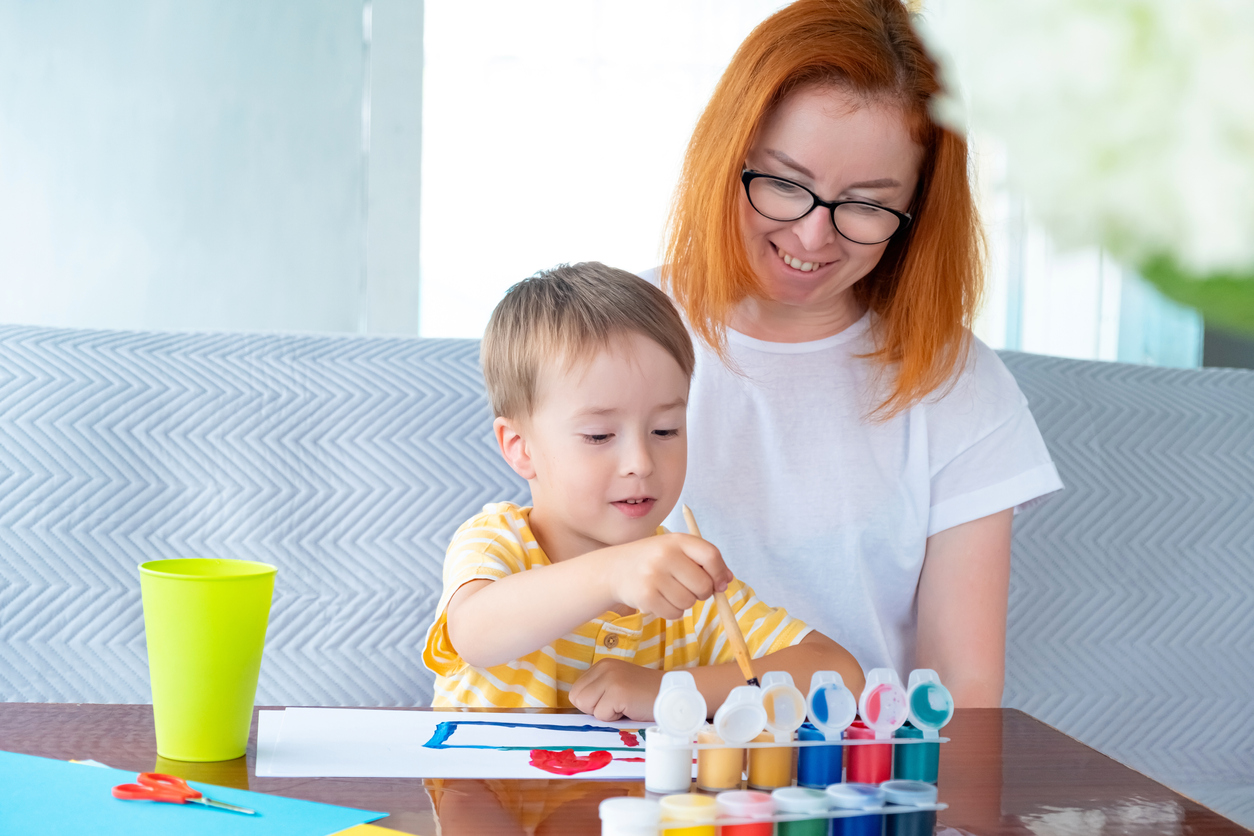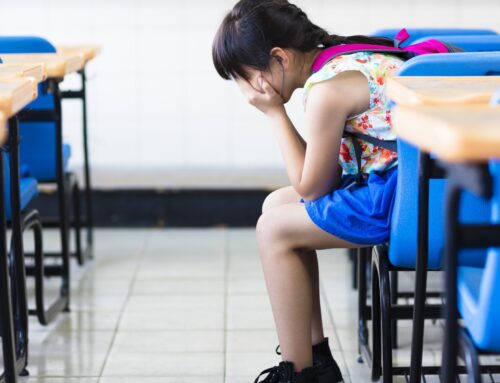
I instinctively knew this was a key learning moment.
I watched my one-year-old look at the (rather large) puddle of water he’d just deposited onto my kitchen floor. He examined it thoroughly with his eyes before squatting down. Gingerly, he drug his index finger slowly from one side of the puddle to the other. He stopped, looked at the water for a moment longer, and then removed his hand. He shifted his position before using two fingers to swish the puddle back and forth eagerly.
Suddenly, he smacked the water vigorously using both open palms, hollering with delight! But, his glee was short-lived. The water flew up, and water droplets hit him squarely in the eye. Blinking in shock, he looked up at me. I gave him a reassuring smile, and he decided everything was ok. Cautiously, he glanced down at his play again.
He jumped up and excitedly stomped his chubby little feet up and down in the puddle, giggling with delight as the water splashed his legs and threatened to drown my house shoes.
I let him play for a moment before grabbing a large towel and showing him how to remedy his earlier mistake by mopping up the sopping mess he’d created. This began a whole new adventure for him as he watched the water disappear into the fabric and learned how to maneuver the towel to capture every last drop!
Every moment of this 10-minute ordeal was full of exciting education for my curious little man.
Learning is a natural state for kids, especially during the early years. It’s innate because that is precisely what their development calls for at that moment. The fact is that, even in the womb, children are either learning or sleeping. If they are awake, they receive information, process it, and file it away to paint a picture of their world on a brand-new, snow-white canvas.
The Children’s Reading Foundation notes that “between birth to age 5, a child learns at a speed unmatched the rest of his or her life! It is during these years – when more than 85 percent of a child’s brain is formed – that crucial brain connections are created. These connections help develop indispensable academic, social, and cognitive skills, which are the basis for learning.”
Kids are natural-born learners, hungry for knowledge and proactively experiencing everything they can to gain valuable perspective. However, as parents, we can cultivate this instinctual desire, nurture it, and encourage our kids to establish a life-long habit of learning.
Earliest Education
If you’ve ever experienced pregnancy in the second or third trimesters, you know the wonder and joy of feeling a whole new little person wiggling around in there. Oddly-timed kicks and sudden summersaults are all the rage in that tiny squirt’s world.
Isn’t it fascinating that your little womb-dweller is already starting their education? Science has given us surprising knowledge of the development of prenatal infants, informing us that they are already eager learners!
Celebree School explains that “even before birth, a child’s brain is capable of processing and transporting information. Studies previously told us that a prenatal baby’s brain can analyze certain information, including their mother’s unique voice and speech patterns, as well as songs and stories repeatedly read to them in-utero.”
Kids come out of the womb already learning. Most already know their mothers more than their mothers knows them! They know her smell, her voice, and other familiar aspects linked to her. So, how do we capture this eager hunger for knowledge to place our tiny babes on the exciting road of forever learning?
How They Learn
Children use a variety of strategies to explore the world around them and draw conclusions.
Cause and Effect
When my one-year-old was exploring the mess he’d made on my kitchen floor, he was primarily experimenting with cause and effect. He was quantifying “if-then” movements. “If my hand does this, what will happen? Oh, this will happen!” He was learning what happens when you run your finger through water and what happens when you apply strong force to the surface of a liquid.
Cause and effect are a primary learning technique for children of all ages — from infancy to preschool and beyond.
Observation
“Children learn and imitate behaviors by watching and listening to others,” explains Michigan State University. “This is sometimes called ‘observational learning,’ when children can learn things simply by observing others. The models do not have to be people that the child directly interacts with. Children learn from models all around them…”
Kids of all ages will watch what happens around them and learn from what they see, hear, and smell. They may or may not imitate what they observe, but they almost always gather and store information from what’s happening around them.
Feel/Touch
If you’ve ever been a parent or caretaker of young children, you know that they touch everything. With little to no regard for safety, sanitation, or logic, their little hands grasp, pinch, poke, swat, and stroke everything.
Touch is a powerful sense in these early years. How the object feels and affects the child’s senses teaches the baby many different things, all in a single touch.
Taste
Have you ever wondered why little kids and babies put almost everything in their mouths? Well, if you guessed it’s because they’re trying to learn something, you have just won yourself a gold star! Objects tell littles a lot about their world from the flavor to the texture. While putting objects into their mouths isn’t always the best idea, it’s a natural instinct that’s nearly impossible to stop a young child from following!
Our Part
Cornerstone University points out, “The simple truth is that the most successful people are dedicated to constantly learning. They recognize that they always need to be growing, always need to be deepening their knowledge, always need to have a more thorough understanding of themselves and the world.”
Kids are born with the building blocks for learning. Education is a natural part of life — not something that adults have decided is a good idea. It’s merely our job to help our kids maximize that instinct and ensure that life doesn’t steal the wonder and joy of learning away from curious minds! Education is everything from book learning to experiential learning, and as parents, we must be involved at every step.
Environment/Lifestyle
Young Children
Creating a safe, loving, stimulating environment for our young ones will help nurture their love of learning and maximize these early years. But we can’t stop when our kids start walking, reading, or even when they enter the first grade!
For young children, this is fairly easy, though specific strategies are helpful:
- Appeal to all five of their senses
- Offer a variety of sensory objects
- Keep objects to a minimum (we want variety, but not overstimulation)
- Atmosphere is important. Calm and cheerful are best
Older Children
Environment is also important for older kids. Try applying these strategies:
- Focus on your home’s atmosphere. Encourage an environment that’s bright and inviting but not overly cheerful. Music and paint colors are a good way to do this, along with natural lighting. Eliminate chaotic tendencies and darker vibes.
- Keep your lifestyle relatively free of distractions (video games, entertainment-based relaxation methods, screen time, etc.)
- From even an early age and into later childhood, cultivate entertainment choices that stimulate the mind, offer educational undertones, and pique their interests (reading, outdoor experiences, at-home experiments, etc.) These habits will become life-long for your kids.
- Don’t forget that older kids enjoy sensory activities, too! They require a bit more of a sophisticated version than a tub full of beans or a ball of playdough, but they still enjoy exploring through their senses.
From experimenting with baking soda and vinegar, trying weird recipes in the kitchen, or even tinkering with mild chemical reactions in the backyard (safely and under appropriate supervision, of course!), kids of all ages love to try new and wild educational activities. Let Carter build that potato cannon, mom!
Your family’s lifestyle and environment will help to shape how your child experiences the world around them. Either, they’ll passively pick up what might cross their path while they drift through life in a less motivated and energetic way… OR they will be proactive learners exploring the world in exciting ways at every turn.
Engagement
Everyone knows that healthy childhood development for babies and toddlers includes positive interactions with adults, caretakers, and other kids in their lives. Their little brains learn and develop based on this engagement. Furthermore, life-long patterns and neuro-connections are created through this stimulation.
It’s imperative that parents of young children actively play with, speak to, read to, sing to, and spend time with their little ones. But keeping this interaction going for the rest of that kid’s childhood is also important.
One way to cultivate a habit of learning from birth is to continue the interactional pattern past infancy and the toddler years.
Examples:
Here are some ways to proactively engage your kids as they age and cultivate that habit of learning as a second nature!
- Include them in household activities while encouraging them to explore and learn through those activities. Cooking/baking is an excellent way to do this. Explore why baking soda makes the cookies fluffy or explore the culinary dishes of various cultures. If you’re mowing the lawn, help them explore what happens to cause the fuel to ignite. Curious minds will instinctively explore no matter the activity. Encourage this through active involvement and by cultivating an attitude of curiosity yourself.
- Talk with them. Constantly. Pose probing questions and point them in the direction where they can find the answers themselves. Allow them to ask questions and take the time to give real answers or find the answers together. As their parent, you’re on this journey with them!
- Debate with them. No yelling, shouting, or tempers flaring. Merely allow for a healthy exchange of ideas and exploration of concepts. Encourage the development of critical thinking skills. Teach them how to think for themselves and use logic to do so. Challenge their preconceptions (and be willing to have yours challenged, too!).
- Read books to them. When they’re old enough to participate, take turns reading. Reading itself expands the mind. Cultivate a love of reading in your child. This can be difficult sometimes since there are countless other ways to relax or chill. But creating a life-long reader is well worth it!
Take it Outside
Encouraging our kids to love the outdoors also encourages them to learn. Nature provides innumerable opportunities for exploration and discovery and is ripe with ideas and concepts to examine. From examining microscopic bugs to gardening, from animal husbandry to exploring nearby springs and rivers, the great outdoors lights a fire under curiosity and stimulates those who love to learn!
“Nature is necessary for a child’s well-being—it nurtures their imagination, uplifts the senses, and promotes happiness and productivity,” explains Pacific Oaks College. “By heading outside and learning in nature, kids improve their emotional, intellectual, and behavioral development. Outdoor learning helps foster the development of creativity, problem-solving, independence, and confidence. They can use their curious minds to explore their environment…”
Family field trips, camping adventures, and outdoor projects with friends are all fun ways to get the kids outside more. Whether your kid wants to know why some plants need more sunshine and water than others, or they need to understand how disease spreads amongst wild animals, inquiring minds have an endless supply of stimulating ideas from nature.
Protect the Instinct
Our kids are born with the natural tendency to learn. Our job is to protect that innate desire and keep a world of distractions from stealing it away. We must feed that curiosity and encourage our kids to continue to explore despite when the Pied Piper of the outside world seeks to coax their young minds down other paths.
Our babies are created perfectly with a serious love of learning. How can we join them on this journey?




